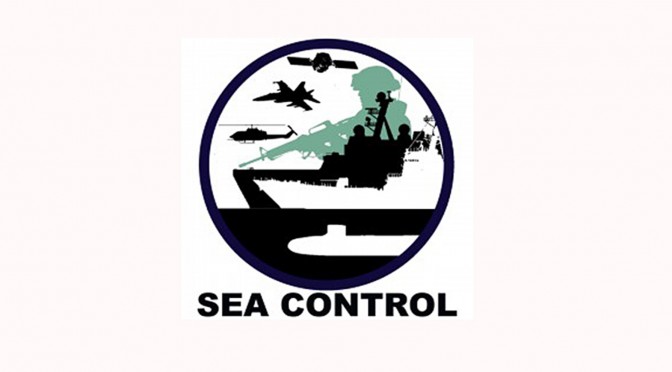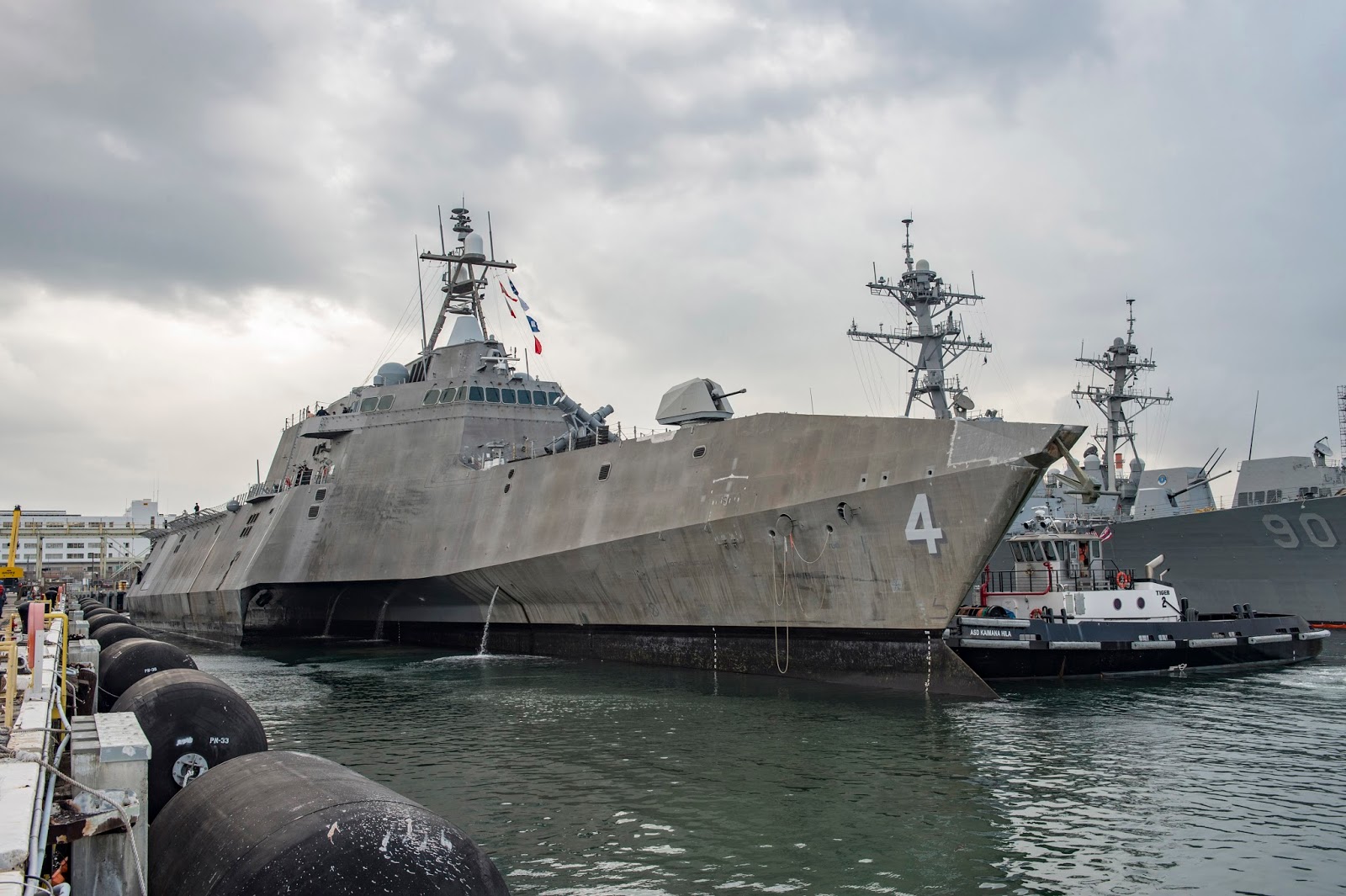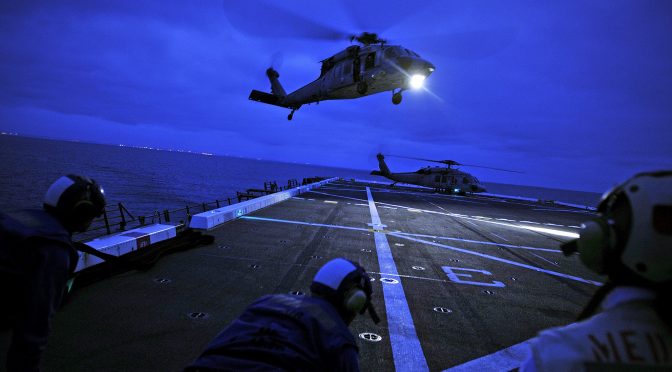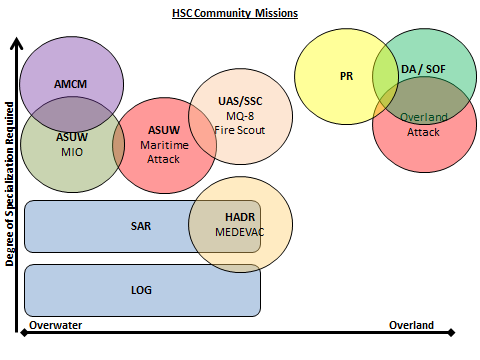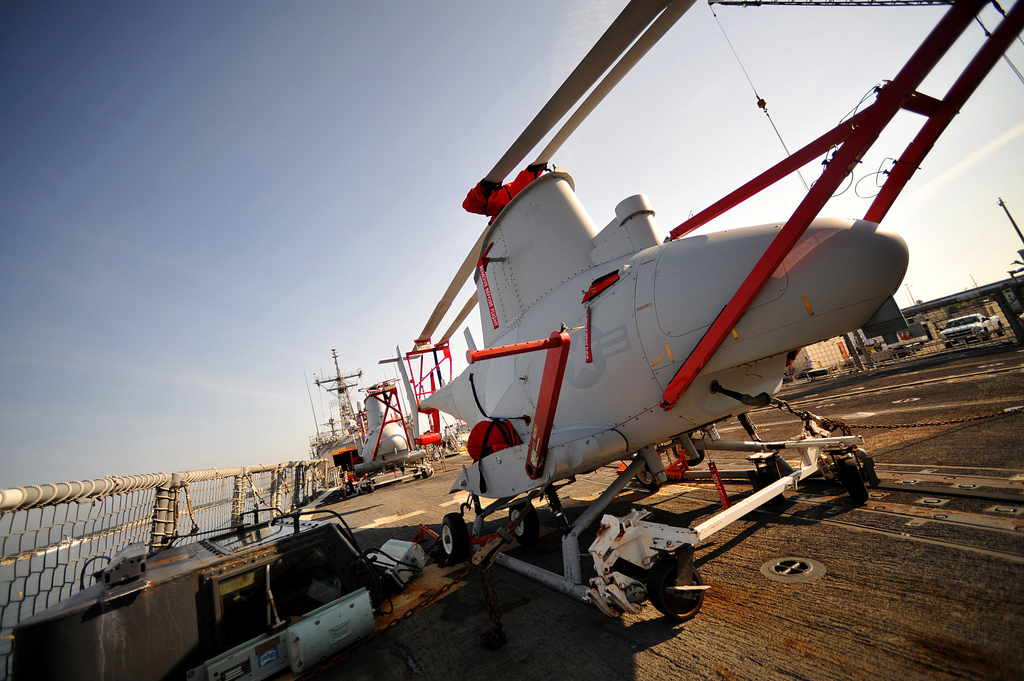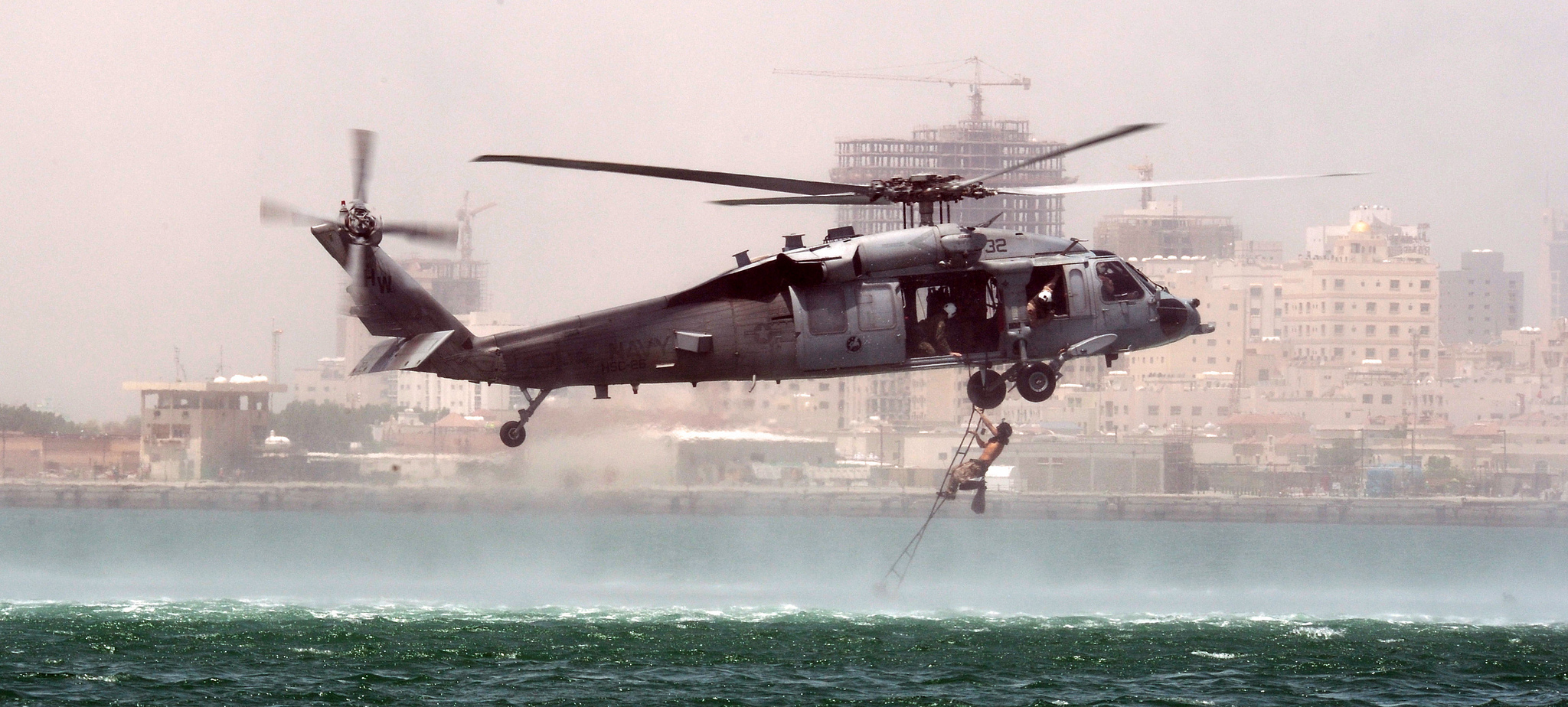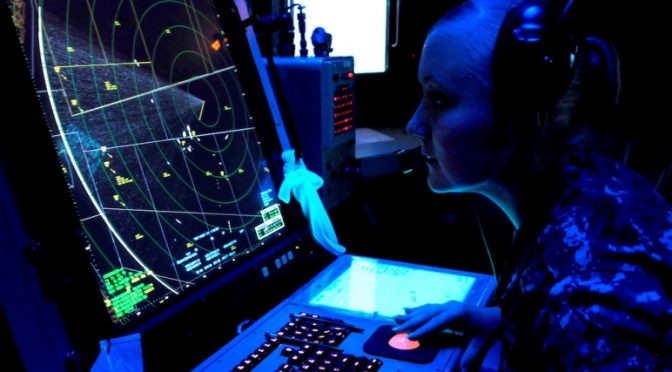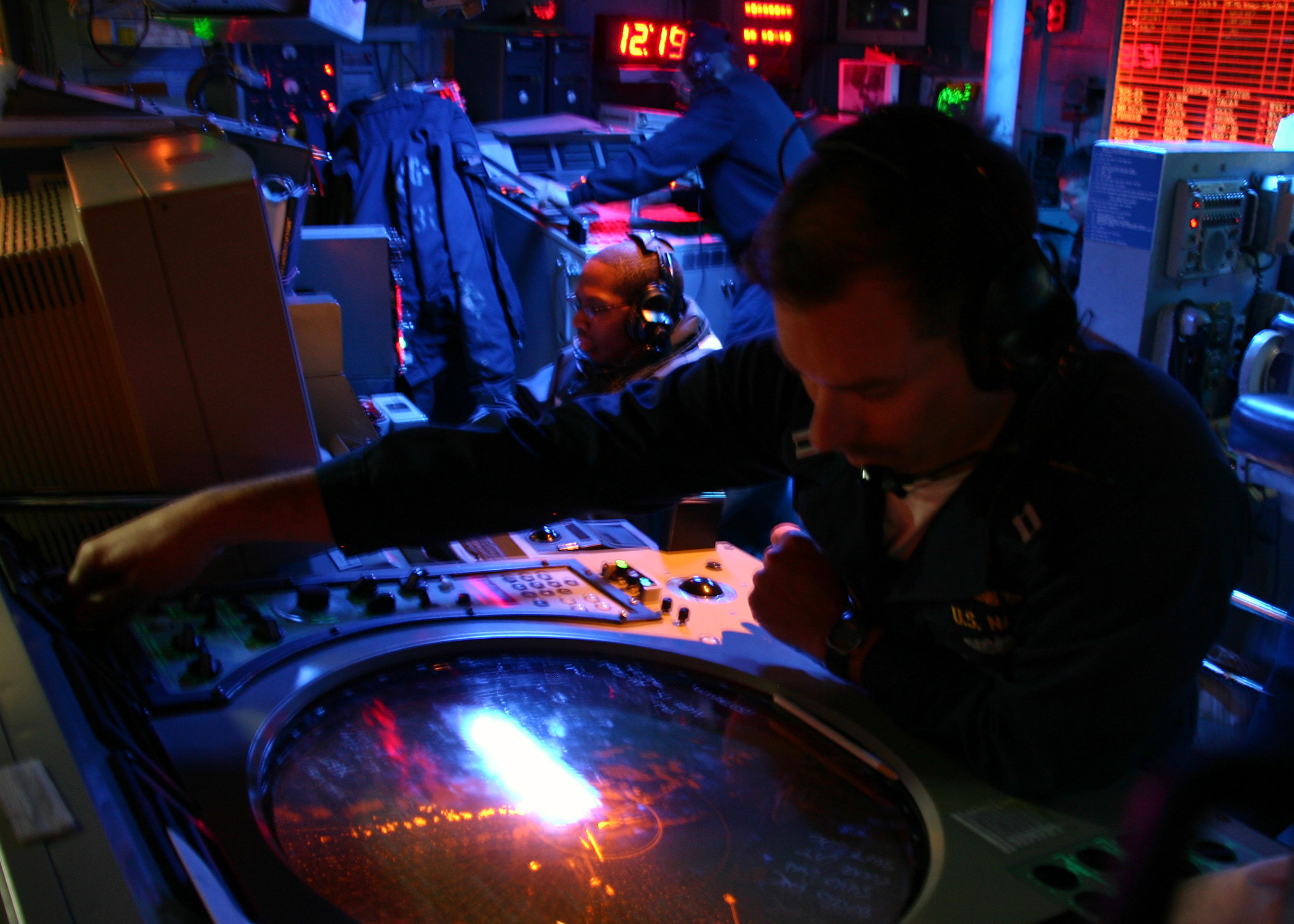By Matthew Merighi
The Naval Surface and Mine Warfighting Development Center (SMWDC) is a critical element of the Navy’s Surface Force Strategy: Return to Sea Control.The command’s four lines of operation are advanced tactical training and tactical guidance development, operational support to combatant commanders, numbered fleet commanders and task force commanders, and capabilities assessments, experimentation, and future warfighting requirements. A critical supporting element in each of these focus areas are the men and women who are trained as Warfare Tactics Instructors (WTIs).
In this interview, Sally DeBoer (SD) spoke with four WTIs who are on the cutting edge of the cultural shift taking place in the surface Navy. Our guests are Lt. Tyson Eberhardt (TE), who is an Anti-Submarine Warfare/Anti-Surface Warfare Tactics Instructor (ASW/SUW), Lt. Brittany Hubbard (BH), who is an Amphibious Warfare Tactics Instructor (AMW), Lt. Benjamin Olivas (BO), who is an Integrated Air and Missile Defense Warfare Tactics Instructor (IAMD), and Lt. Damon Goodrich-Houska (DGH), who is an ASW/SUW WTI. Read the transcript or download the audio below.
Download Sea Control 139: What Does It Mean To Be A SMWDC Warfare Tactics Instructor?
SD: Welcome back! On this episode of Sea Control, our guests today are four Warfare Tactics Instructors from the Naval Surface and Mine Warfighting Development Center (SMWDC) in San Diego, CA. Thank you all so much for taking time out of your schedule to join us today. Let’s begin by getting a little background on each of you. What did you do prior to coming to SMWDC, and what drew you to the command?
TE: I was the ASWO officer and navigator on USS Preble as a division officer, I really enjoyed the tactical aspect of getting to meet sonar technicians and finding submarines. As a division officer, the opportunity on shore duty to expand my knowledge base and help other ASWOs drew me to the command.
DGH: I served on USS Reuben James and as the training officer on the USS Rushmore, part of that tour was going through a training cycle where you get the crew and all the watchstanders up to the level they need to be to deploy. With that experience, I got to conduct drills, run through scenarios, and train sailors. What drew me to SMWDC was the opportunity to learn and implement advanced tactics, then train warfighters on how to fight more effectively, I really enjoy ASW especially.
BH: I spent my first division officer tour on the USS Green Bay, and then I moved to a destroyer, the USS Lassen, as the damage control assistant. What interested me in SMWDC was going back to my roots as an amphibious sailor. A lot of the mission sets we conducted with the Marine Corps taught me how to be a liaison and work on the relationships between sailors and our USMC counterparts. That is what interested me in joining this program.
BO: Before I came here, I was the communications officer on USS Paul Hamilton and then I was the training officer on USS Michael Murphy, both out of Pearl Harbor. I served as air warfare coordinator and I came from a background where most of my captains knew this domain really well; I truly enjoyed that billet. Working with sailors and teaching people was something I also found enjoyable. When I heard about SMWDC, I thought what better way to use all this knowledge I have accumulated, pass it on, and make a difference?
SD: What impact do you see from the work you have done at SMWDC?
DGH: One of the biggest things I have seen is a culture shift, and one of the main aspects is the PBED (Plan, Brief, Execute and Debrief) model. If you look at elite athletes, they don’t just go out and do their event, they will study, watch videos of themselves doing the actions, look over the minute details to improve, as well as watch competitors to adapt techniques and methods.
So we go out and do Surface Warfare Advanced Tactics and Training (SWATT) and have WTIs on each ship and, after doing various events, we will actually show the crew and the watchstanders a replay of the event, including voice recordings of reports. Walking through that, we start with the WTIs doing the majority of the presentation with the watchstanders and crew jumping in here and there, but by the end of the training, the watch teams are running things on their own and identifying issues themselves. So, seeing that training change hands from the WTIs to the ship’s crew, to where they are able to conduct their own training and self-improvement, is really great.
TE: We also conduct training ashore, so my primary job as an advanced sonar instructor is to provide this advanced tactical instruction to officers that will go out and conduct training. This classroom training is another important part of our mission. Getting to work with officers before they go to sea is another exciting part of our mission here.
BO: We tend to pride ourselves on not just conducting training but also building knowledge. One of the things that we have done is try to apply the same type of teaching approaches we learn from our counterparts. We put them through the ringer here in terms of making them go up and do a brief, do it well, and do it repeatedly to the point where they’ve put in so many hours, done so much research, taken and internalized these techniques…this goes for all of the schools here. So when you see a sailor give a brief, you know you will get a certain product because it’s been tailored a certain way. Since we have been doing it this way, we’ve seen a great payoff.
SD: How does the reported success of the WTI program in improving tactical proficiency translate to future training development for the Navy’s SWOs?
BH: I think that the three different schoolhouses that we currently have provide a good baseline for how we expect our future SWOs to participate in developing tactical proficiency. We take an elite cadre of junior officers and we put them through these schoolhouses and then, as we complete our production tour, which is anywhere from two or three years, those same officers then go back out to the fleet as department heads that will eventually be XOs and COs. So we are bringing our tactical proficiency to a new standard.
DGH: Another point is that as we develop new tactics and doctrine, we get a chance to take it out to sea with real world watchstanders to test it out and make sure that it is up to par, that it’s effective, and if not, we can make adjustments very rapidly.
SD: Is the emphasis more on teaching rigid existing doctrine or on allowing WTIs to develop and pursue new, original ideas?
DGH: It’s a little of both. We do rely on doctrine, but we also take our WTIs and ensure that we apply rigor, academic rigor, to our doctrine and tactics to make sure they are in fact reliable, and if there are issues, then again we identify them, correct them, and ensure the WTIs are empowered to enact changes and improve things.
TE: I think to Damon’s point, we have WTIs out at sea who have a responsibility to know the doctrine and the guidance, but have the opportunity to think critically and bring new ideas to the organizations. We’ve taken a more active role in events like the SCC (Submarine Command Course) where we have a chance to try out new tactics and see how effective they can be, then feed that back into formalized doctrine.
BO: One of the good things about being able to test out new TTPs and doctrine is also being able to apply those things earlier and develop that muscle memory. The more we internalize tactics, the more they are applied and become part of the ship. Out there on the water where officers are asked to make quick decisions, this muscle memory represents a force multiplier for the entire fleet.
SD: How do you see yourselves speeding up and improving the Navy’s ability to field new thinking and capabilities?
BH: A lot of what we do when we go out to ships and in the schoolhouse is not only study current doctrine but also evaluate new ways of utilizing that doctrine. We receive immediate feedback from the ships, and then we conduct workshops and working groups that take a really hard look at what we are currently teaching and make sure it is the best way to conduct that event.
BO: The other thing we’ve hit on in terms of improvement is the impact that we see in the classroom, the way we teach. Being able to sit down and listen to briefs and take them in has created a much better experience for the students, they take on a lot of what we’ve done and they “get it.” We have created these lessons so when they walk away from classrooms they’re ready to use what they have learned. We use the ARCS (attention, relevance, confidence, satisfaction) approach – we see that as a feedback loop for the students. Once we have their attention, we present relevant information. Confidence means that they can walk away feeling like they “get it,” and satisfaction (S) means they can go to their ships and into combat or an exercise and satisfactorily apply the things we’ve taught them.
DGH: To add on, in operational environments, the more we get WTIs out to the ships as DHs, especially once we hit that critical mass where there’s one WTI per ship, we will have already created a network of WTIs that all know how to get in touch with subject matter experts (SMEs) in various areas. Much of that reach back comes here (SMWDC HQ), and we have good communications with the aviation and undersea communities, etc.
As things change and real world events occur, we rapidly take in feedback and develop new tactics and doctrine as needed. We can model new systems going into the fleet, and any feedback from doctrine and tactics used in the real world can be brought into the classroom to make sure that the next set of WTIs that head out to train others have the most up-to-date information. We are not teaching out-of-date stuff, we are teaching the latest and greatest.
SD: What kind of collaboration and integration do WTIs have with one another and different communities (aviation, undersea, etc.)?
BH: So, one way that we do this is anytime we have a course that we are trying to teach or area of interest we need more information on, we reach out to that community. For example, we are participating in an SCC (Sea Combat Commander) course for various DESRONs and PHIBRONs working through training cycles. We recently reached out to the aviation weapons schools for input and participation to make sure we are as tactically proficient in the relevant areas we are teaching as they are.
TE: Along those lines, an important part of what WTIs do is that broad reach. While we train WTIs here at SMWDC, others are working for various other schools and groups and counterparts that have a specific focus. That allows us as a community of WTIs to try and foster cross-domain thinking about problems that don’t just affect one area, but affect the whole spectrum of naval warfare.
SD: How can you work to keep your skills current in an age of rapid change?
DGH: We have a lot of WTIs here that are traveling, going out and doing various events, training aboard ships, and getting a lot of great experiences, such as live fire events, things that previously were something an officer might get to do once or twice in a career, we have WTIs doing multiple times a year.
What we ended up starting was what we call “Tactical Taco Tuesday,” which we hold multiple times a month. It is a long working lunch where we cross-train between domains, IAMD folks, ASUW, ASW, and amphibious folks. We also pull in other warfare areas as well, such as CW or Intelligence, and get some good cross-training in a less formal environment that allows for really good quality discussion and in-depth questions – plus everyone brings food so it builds an esprit de’corps that keeps the WTI network strong.
When we go on to our next tours, we know who to talk to and who the experts are. The more formal way we do this is that when WTIs come back to the schoolhouse, which we call Re-Bluing, we conduct refresher courses where the latest and greatest TTPs are taught.
SD: What do you think is next for SMWDC and the WTI program? How do you envision WTIs being utilized five or ten years down the line?
BH: I think that as WTIs, this is simply a two or three year tour, but when we leave this production tour, we do not take off our patch, it is still up to us to continue remaining as tactically proficient as our patch would designate us to be. So in 5-10 years, the goal is to be DHs, XOs, and COs, all the while continuing to build that knowledge base that we started back during a WTI production tour.
DGH: As we have more and more senior leadership who are WTI-qualified, it’s going to push an overall culture change, much like the phrase “a rising tide raises all boats,” it’s that idea that as increasingly more senior leadership has experience as WTIs, they will maintain that emphasis on being the best, drilling hard, working on doctrine and tactics, and that will really shift our focus.
WTIs are supposed to be warriors and thinkers and teachers, so when we get out and stand tactical watches, those same WTIs will be thinkers and work on doctrine, tactics, and improving existing processes as well as developing new systems and ideas, while also serving as teachers, in that they will train watchstanders, crews, and even strike groups. Ultimately, this will improve our warfighting ability.
BO: One of the things that we really hammer home is that this command is primarily O-3s and O-4s, which in the grand scheme is very junior in rank, but we are the ones doing the homework and teaching people in ranks above and below. Ultimately, I think what we are trying to get at is that the tactical experts will be the gatekeepers and have the breadth of knowledge to build something great.
TE: The WTI program is an effort to put warfighting first among SWOs. As SWOs we have so many things we have to be proficient at, but the bottom line is we need to be warfighters, and this requires an advanced understanding of tactics. And by building this cadre of WTIs, for years down the line as DHs and beyond, we will be making an impact by bringing that to the fleet
SD: What is your message to aspiring surface warfare officers who are interested SMWDC?
TE: I think what most excites me about getting to be a part of this command is that the Navy is investing in my level of knowledge and in my ability to go out and lead sailors in the future. It is exciting to train others, to do these exercises. The bottom line is that every single day I come to work I learn something new, and the organization is committed to training me to a higher level of knowledge that will pay off for years as I have come to a whole new appreciation for expertise in surface warfare.
DGH: For aspiring SWOs, as a JO, as a non-qualified SWO working toward that pin, you have much to learn and focus on, but number one I would encourage young SWOs to learn as much as you can and focus on tactics, but communicate early with your chain of command that you’re interested in the WTI program if you have a passion for tactics and training. Of course, work on your qualifications and do your job well, but there are many opportunities to become qualified in warfare areas as a JO, whether it’s ASWE for a second tour or various air warfare qualifications on an Aegis platform. Focus on those and work toward being the best tactician you can in whatever position you are in – strive to be the “go-to” guy or gal in that position. So when you do apply to be a WTI, those recommendations will really help.
BH: For SWOs looking to come here, this is probably going to be a once-in a-career type of opportunity. Every day when I come to work, my job is to take research, take what we’re doing, take a schedule, and make it the best that I can for the fleet, event, or scenario. There wasn’t a time in the first four years of my career where someone asked me to research tactics or to figure out a problem – but for all SWOs this is your time. You’re two to three years out of your career that you can spend just focusing on making the warfare areas better, building relationships, and networking. In that way it is different from many tours you could do otherwise.
BO: Looking back on everything, I think all of us are close enough to our JO tours to realize that being a junior officer onboard a warship is not an easy task. It is a lot of sustained hard work that keeps you up many nights studying. We understand how hard you’ve worked for your pin. The shore tour is a time when many look to take some gas off the pedal and regroup. Here we have an opportunity to do that, but we also have a lot of work to do, but it’s good work. It is something that is going to make a difference.
Quite frankly, of all the people I have worked with in my career, there is no one I would rather work with. The people here are trying to make a difference, and that work will echo in the Navy for many years to come. My takeaway to you is, if you’re qualified in an area, pursue it rigorously, look at the pubs, talk to the watchstanders, and ask as many questions as you can, because one day you may be the one teaching others to do that and it is going to matter. That is why we were created.
SD: Thank you all so much for taking time out of your day to join us here on Sea Control and for leaving our listeners more informed about the work you’re doing and the mission of the Surface and Mine Warfighting Development Center. We hope you’ll join us again! For our listeners – this has been another episode of Sea Control. Thanks for listening!
Lt. Benjamin Olivas is a native of El Paso, Texas and earned his bachelor’s degree in history from the United States Naval Academy in 2011. He received a commission in the Navy and was selected to be a Surface Warfare Officer. Olivas is an Integrated Air and Missile defense Warfare Tactics Instructor (IAMD WTI), and currently serves as the Standardization Officer at the Surface and Mine Warfighting Development Center (SMWDC) in San Diego, CA.
Lt. Brittany Hubbard is a native of Grand Chain, Illinois and earned her bachelor’s degree in psychology from University of Illinois in 2012. Hubbard is currently at SMWDC Sea Combat Division as an Amphibious Warfare Tactics Instructor.
Lieutenant Damon Goodrich-Houska graduated from Indiana University in 2010 with a Bachelor of Science degree in Public and Environmental Affairs. Damon earned his commission through Officer Candiate School in 2010. Additionally, he earned his master’s degree in Cyber Security from National University in 2016. Lieutenant Goodrich-Houska is currently assigned to Navy Surface and Mine Warfighting Development Center as N5 Anti-Submarine Warfare Assistant, N5 Doctrine & Tactics Branch. Damon completed the Legacy SuASW WTI course at the top of his class, and completed the ASUW/ASW WTI Pilot Course as the honor graduate.
LT Tyson Eberhardt is a native of Seattle, Washington and earned his bachelor’s degree in from Princeton University in 2008. He holds a master’s degree in education from the University of Pennsylvania. Eberhardt earned his commission through Officer Candidate School in 2013. He is currently an ASW/SUW Warfare Tactics Instructor at SMWDC Sea Combat Division specializing in active sonar systems and tactics. During his time at SMWDC he also served as the uniformed lead for SHAREM 188 with the ROK Navy.
Sally DeBoer is an Associate Editor with CIMSEC, and previously served as CIMSEC’s president from 2016-2017.
Matthew Merighi is the Senior Producer for Sea Control.

